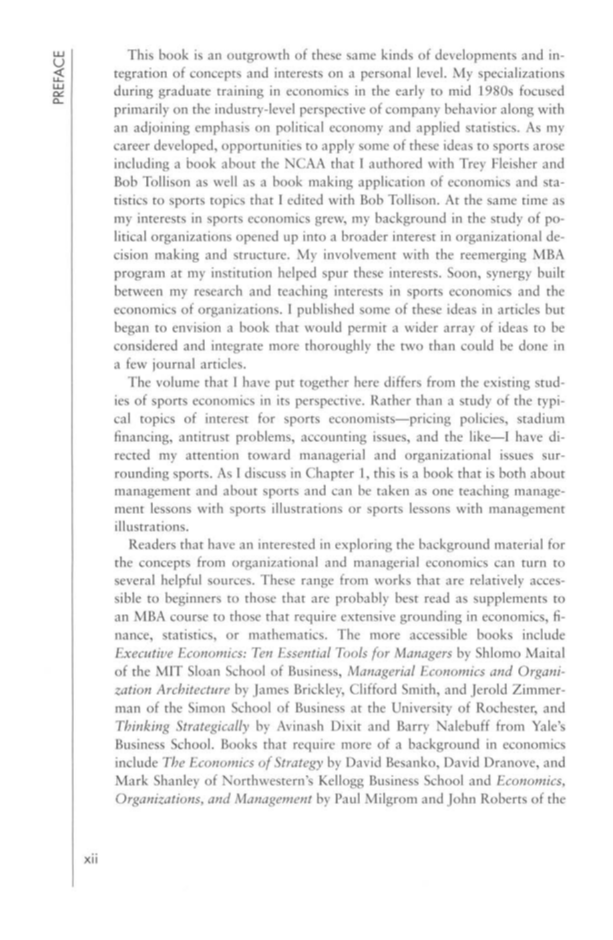This book is an outgrowth of these same kinds of developments and in- tegration of concepts and interests on a personal level. My specializations during graduate training in economics in the early to mid 1980s focused primarily on the industry-level perspective of company behavior along with an adjoining emphasis on political economy and applied statistics. As my career developed, opportunities to apply some of these ideas to sports arose including a book about the NCAA that I authored with Trey Fleisher and Bob Tollison as well as a book making application of economics and sta- tistics to sports topics that I edited with Bob Tollison. At the same time as my interests in sports economics grew, my background in the study of po- litical organizations opened up into a broader interest in organizational de- cision making and structure. My involvement with the reemerging MBA program at my institution helped spur these interests. Soon, synergy built between my research and teaching interests in sports economics and the economics of organizations. I published some of these ideas in articles but began to envision a book that would permit a wider array of ideas to be considered and integrate more thoroughly the two than could be done in a few journal articles. The volume that I have put together here differs from the existing stud- ies of sports economics in its perspective. Rather than a study of the typi- cal topics of interest for sports economists—pricing policies, stadium financing, antitrust problems, accounting issues, and the like—I have di- rected my attention toward managerial and organizational issues sur- rounding sports. As I discuss in Chapter 1, this is a book that is both about management and about sports and can be taken as one teaching manage- ment lessons with sports illustrations or sports lessons with management illustrations. Readers that have an interested in exploring the background material for the concepts from organizational and managerial economics can turn to several helpful sources. These range from works that are relatively acces- sible to beginners to those that are probably best read as supplements to an MBA course to those that require extensive grounding in economics, fi- nance, statistics, or mathematics. The more accessible books include Executive Economics: Ten Essential Tools for Managers by Shlomo Maital of the MIT Sloan School of Business, Managerial Economics and Organi- zation Architecture by James Brickley, Clifford Smith, and Jerold Zimmer- man of the Simon School of Business at the University of Rochester, and Thinking Strategically by Avinash Dixit and Barry Nalebuff from Yale's Business School. Books that require more of a background in economics include The Economics of Strategy by David Besanko, David Dranove, and Mark Shanley of Northwestern's Kellogg Business School and Economics, Organizations, and Management by Paul Milgrom and John Roberts of the XII
Document Details My Account Print multiple pages
Print
You have printed 0 times in the last 24 hours.
Your print count will reset on at .
You may print 0 more time(s) before then.
You may print a maximum of 0 pages at a time.
































































































































































































































































